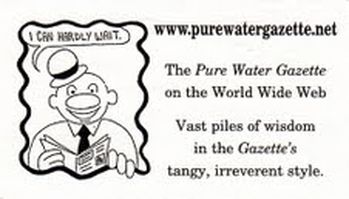Special Mid-Month Issue January 15, 2013 |
|---|
We hope you'll read the Pure Water Gazette's "Today's Top Water News" section. New articles appear daily. Some examples of recent posts are included in his issue. |
In the News
Lake Michigan and Lake Huron Reached Record Low Levels
According to a TV station in Traverse City, Michigan, the Great Lakes have had consistently low water levels this past year, but now they have reached an all-time, record low.
US Government sources said preliminary numbers show both Lake Michigan and Lake Huron reached record low water levels in December.
Low water levels are blamed on light snowfall last winter and light rainfall in the spring.
The previous all-time low level was set in 1964, at 576.2 feet.
The preliminary mark for December 2012, is 576.15 feet. It is expected that the 1964 record low will be broken soon.
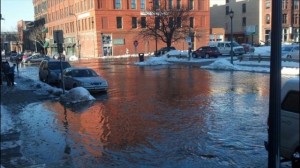 |
|---|
Many large buildings in downtown Minneapolis were without water for several days in early January, and traffic had to be rerouted around certain parts of the city because of a ruptured water main that dumped 14,000,000 gallons of water into the area. More.
|
Basic Terms and Measurements for Home Reverse Osmosis Owners
by Gene Franks
Performance of home reverse osmosis units is measured with the same criteria and tools as larger RO units. Here are some basics:
TDS. The most common measurement of reverse osmosis performance. TDS stands for “total dissolved solids.” It is measured with a simple meter that passes a small electrical current through the water and measures how well the water conducts electricity. The more “dissolved solids” the water contains, the better it conducts electricity, and the higher the reading on the meter. Conversely, low conductivity means few solids and a low reading on the meter.
The meter in the picture below can be used to measure the tap water as well as the RO water. It is the comparison of the two, called “percent rejection” (see below), that really tells how well the unit is performing.
Most municipal tap water will have a TDS reading of 500 parts per million (ppm) or less. (The reading may be expressed as ppm, parts per million, or mg/L, milligrams per liter. Ppm and mg/L are the same.) The EPA regards 500 ppm as the maximum recommended TDS for drinking water (although many cities’ water exceeds this).
TDS is merely a way that performance is measured. A high TDS does not indicate that water is contaminated with dangerous pollutants. It means mainly that it has lots of minerals in it. TDS consists mainly of minerals like calcium, magnesium and sodium.
The more of these solids that the RO membrane “rejects” (removes), the better it is working.
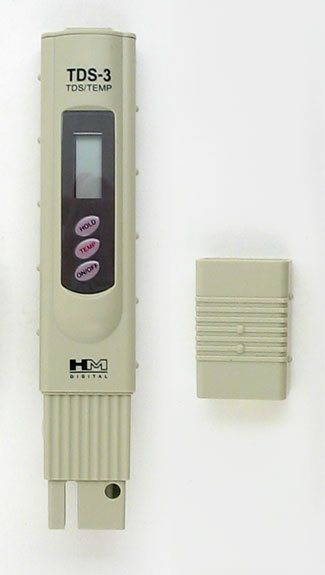 |
|---|
| Modern Total Dissolved Solids Testers Give You An Instant Picture of the Effectiveness of Your RO Unit. You Can Also Use It to Test Your Tap Water for Comparison. It's easy to own a TDS tester. Just $33. |
Percent Rejection
In general, most modern residential reverse osmosis units reduce the TDS of tap water by 90% plus. Your home unit is running fine if the water coming out of the RO unit is only about 10% of the tap water. In other words, if your tap water reads 300 on your meter, if your RO unit reads 30 or less there is no reason to consider changing your membrane. The 10% rule works fine, but if you want to be a bit more scientific, you can figure what is called the “percent rejection” of the unit. Here’s the formula:
Tap water TDS minus RO water TDS divided by tap water TDS times 100.
For example, if your tap water reads 289 and your RO water reads 16, work the forum la:
289 – 16 = 273/289 = .9446 X 100 = 94% rejection.
This means that your RO unit is rejecting (removing) 94% of the solids from your tap water. It is safe to assume it’s doing an excellent job reducing not only the minerals in the water but also the lead, arsenic, and fluoride.
Measuring TDS is an effective means of determining the overall performance of your RO membrane.
Measuring Output
An easy way for determining how many gallons per day your RO unit is producing is to measure how many milliliters the unit produces in a minute and multiply the result by 0.38. To do this, turn off the valve on your storage tank so that no water can go in or out, then lock open the ledge faucet on your sink top. The small stream or drip that comes from the faucet is the amount of water the RO unit is producing in real time. Catch the drip or stream for one minute in a measuring cup that shows milliliters. Multiply the milliliters produced during one minute by 0.38 to get gallons per day.
For example, if your unit produces 60 milliliters in a minute, multiply by 0.38 and you’ll see that your RO unit is making about 23 gallons of water in a 24 hour period.
The Perils of Drinking Water
by Hardly Waite
Being a parent is not easy.
A mother, seeking to protect her daughter from what is certainly a great dangers to children, the soft drink, buys her child a stylish metal water bottle and is delighted to see that she uses it, carrying the bottle to school and to the mall, drinking water instead of the ubiquitous soda. Soft drinks, after all, are clearly associated with the epidemics of childhood obesity and diabetes, and as has been recently revealed, depression. Mom doesn't have long to rejoice, however, because she learns via an NBC news report that the stylish metal bottle, which encourages her child to drink water while avoiding the potential chemical hazards of plastic bottles, is itself a very dangerous item.
Several children have had traumatic experiences when their tongues were caught in the neck of a metal drinking water bottle. As unlikely as this seems, it has happened several times--enough for one manufacturer to take his bottle off the market--in recent months. Once the tongue has been inserted into the bottle, it swells quickly and ridges on the bottle neck make it impossible to extract the tongue. In a recent case (see picture below) a young girl required difficult surgery to extract her tongue from the bottle, and she was hospitalized for several days.
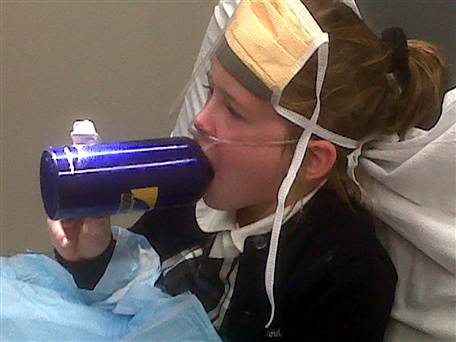 |
|---|
Seeing the NBC video will make you realize that drinking from a metal water bottle may be as dangerous as licking an icy pump handle. |
Some other dangers concerning water that you many not be aware of:
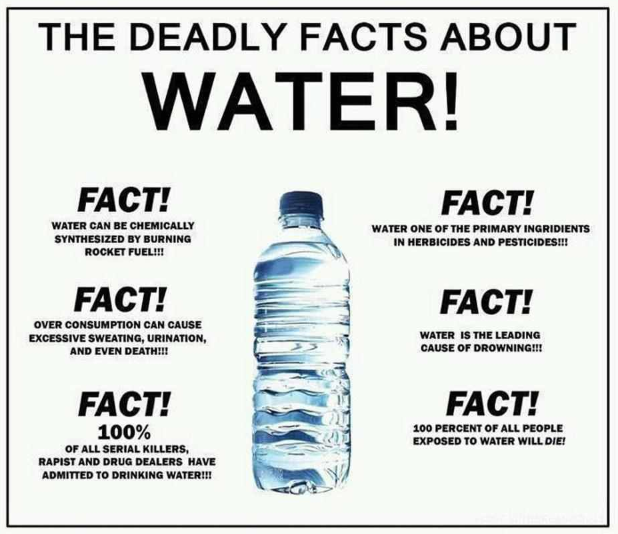 |
|---|
The Advantages of Being Ordinary: Why Standard Sized Water Filters Are Best
Things get to be standard for a reason. -- Latvian Proverb.
If you own one of the many popular drinking water systems that use uniquely sized replacement filters--Aquasana, Brita, and Pur, for example--the total number of replacement cartridges you have to choose from are one. That's because the manufacturer has made the filter so that it will accept only one cartridge size--the size that the manufacturer alone makes. This system is known in the industry as proprietary sizing. The purpose is to assure the maker that you can buy only his cartridges. It also relieves the maker of the need to provide variety. One-size-only normally also means one-style-only. Whether your water is treated with chloramines, chlorine, or nothing at all, you get the same filter cartridge. If your water has lead or no lead, fluoride or no fluoride, it's the same cartridge.
If, on the other hand, you own a drinking water system that uses a standard 9.75" X 2.5" filter cartridge, you can choose from literally dozens of different cartridge styles, and you can even buy a cartridge from a manufacturer other than the one who made the filtration system. This size, which we call Size 1 for convenience, is the most commonly made filter size. Almost anyone who makes water filters makes some cartridges in this size.
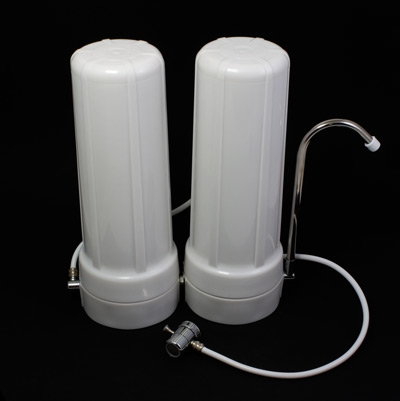 |
|---|
This classy double countertop filter uses standard-sized 9.75" X 2.5" filter cartridges. This means you have many dozens of cartridges to choose from, allowing such treatment options as nitrates, arsenic, and fluoride not possible with "one size fits all" countertops. Furthermore, use of two similar or identical carbon blocks gives many times the chemical filtration capacity of small proprietary filters. |
Below are some examples of standard-sized cartridges that will fit all standard-sized filtration units, countertop filters, undersink filters, reverse osmosis units, add-on filters, and even garden hose filters.
MatriKX CTO Plus. Carbon block, rated for 20,000 gallons of chlorine reduction, it's a great filter for chlorine, chloramines, VOCs, chemicals in general, plus excellent taste/odor performance. A very tight nominal 0.6 micron filter.
MatriKX VOC. A tight 0.6 micron coconut shell carbon block. Designed for overall performance on chlorine and chemicals, but is especially good at VOC reduction.It's a great taste/odor enhancer as well.
MatriKX CTO. A nominal 5 micron carbon block. Free flowing, excellent all around filter that is especially good as a reverse osmosis prefilter.
MatriKX PB1. A great one-cartridge drinking water filter, it is a tight 0.5 micron carbon block (too tight for use in reverse osmosis units) with lead reduction and cyst removal capability.
Doulton Super Sterasyl Imperial. An oversized-Doulton ceramic cartridge with a carbon core, this is one of several Doulton cartridges made to fit standard housings. Its strong point is removal of bacteria and cysts, but it's also a good all-around chemical filter. While Doulton undersink and countertop units command a premium price, the regular-sized cartridges can fit into any housing. This means that you can buy our Model 77 countertop with a Doulton cartridge and the whole unit costs only $77--the same filtration for less than half the price of the manufacturer's original.
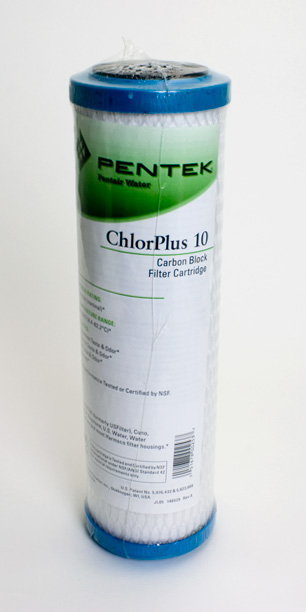 |
|---|
| The ChlorPlus 10 cartridge made by Pentek fits any standard housing. An excellent all-around carbon block, it is designed to be especially good a chloramine reduction. It fits our countertop filters, undersink filters, and our Black and White reverse osmosis units. More information. |
The standard filters shown above are all "radial style" cartridges. This means that water to be filtered passes through the outside wall of the filter cartridge and works its way into the core. The cartridge, therefore, has a very large filtering surface.
There are also many "axial style" cartridges that fit in standard housings as well. These interchange with radial filters and no modification of the housing is needed. Axials work differently. Rather than flowing through the side of the cartridge to the center, with axials water enters one end of the cartridge and flows the entire length of the cartridge to exit the other end. Cartridges of this type are often called "media" cartridges, since they use granular filter media. Most specialty cartridges (fluoride, nitrates, arsenic, etc.) fall in this category. Granular carbon cartridges as well are almost always axials.
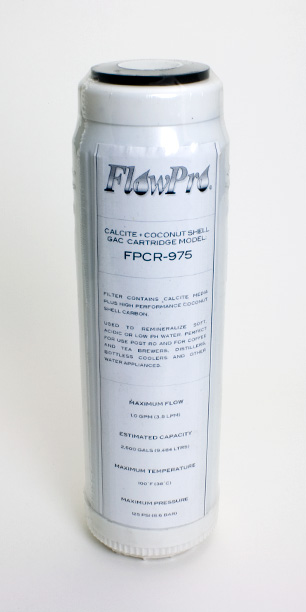 |
|---|
| Above is an "axial" style media cartridge. It contains calcite, a sacrificial medium that raises pH and adds minerals to low pH water, plus coconut shell carbon for taste/odor and chemical treatment. Its most common application is as a reverse osmosis postfilter. More information. |
We stock axial media cartridges for reduction of lead, fluoride, iron, chlorine/chloramines, hydrogen sulfide, nitrates, and arsenic, as well as cartridges to deionize water (remove all "TDS"), increase pH, soften, and prevent scale by sequestration.
We also stock sediment reduction cartridges in this size from 20 microns down to 0.35 microns and in all three popular sediment styles--wound string, spun poly, and pleated poly.
Our regular cartridge menu provides details about all our cartridges, in all sizes. The Size 1 offerings described above are here. And if you know what you're looking for, we now have a very compact listing of cartridges that makes ordering online fast and easy.
Early January Water News
The Pure Water Gazette features a top water news story each day. Here's what you missed in the first half of January if you haven't been reading the Gazette:
The new Gazette format also indexes much of the significant content of the old online and paper versions of the Pure Water Gazette. Take some time to browse. As our ad says, you'll find "Vast piles of information in the Gazette's tangy, irreverent style."
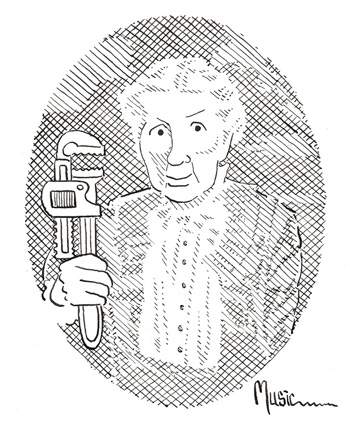 |
Sanitizing Water Softeners and Hot Water Heaters, the Easy Wayby Pure Water AnnieTechnical Wizard Pure Water Annie Describes How to Use Common Bleach To Do the Job |
|---|
Keep your Water Softener and Hot Water Heater Clean
Hot water heaters are often the source of unpleasant odors. Bad smelling water can result from a variety of causes, such as hydrogen sulfide gas, bacteria, or smelly sacrificial anodes in the heater, but whatever the cause, a good dose of common household bleach will often solve the problem. Sanitizing the heater isn't the answer every time, but it's fairly easy and it does no harm, so it's a good place to start.
The hard part is finding a place to inject the bleach. If you have an existing cartridge style filter upstream of the heater, it's usually easiest to remove the filter cartridge and use the filter housing as an injection point.
If you don't have a filter, about $25 can buy a regular housing for a 10" x 2.5" cartridge with an off/on valve built into the head that includes a pressure relief valve button. The valve-in-head style is easiest to install because you won't need to add a shutoff valve.
To disinfect the water heater,
fill the filter (sans cartridge) housing 1/2 to 3/4 full of regular household bleach and then run hot water into the kitchen sink. Smell the water for bleach, and when you smell it shut off the water. Don't use hot water for a couple of hours to give the bleach time to do its work. (If you don't smell bleach after 10 minutes or so of running the water, you probably need to add more bleach and start over.)
The softener is easier to sanitize because you'll simply be adding bleach to the brine tank. To sanitize the softener, use about 1/4 cup of unscented regular bleach in a gallon of water and pour it into the water in the salt tank. Let it set for an hour and then do a manual regeneration. Don't use water until the regeneration is finished. Doing the regeneration on your way to bed is best.
After 15 Years of Drilling, Russians Have Brought a 2 Meter Slab of Ancient Ice to the Surface
As we previously reported, Russian scientists have been drilling under the most difficult of conditions in an effort to reach a body of water called Lake Vostok that has been isolated from the rest of the planet for at least 20 million years. The lake lies 2.5 miles beneath the surface of Antarctica. It is 160 miles long and 30 miles across.
 |
|---|
| A summer day on the frozen surface of Lake Vostok. The water is under 2.5 miles of ice. It took the Russians 15 summers to drill through the ice. |
Drilling through the 2.5 miles to hit the lake has been done under the most brutal of conditions in an area where temperatures have been recorded down to -129F. Drilling was possible only during the short summer season, and it has stretched out over 15 years.
In February of 2012 the drilling paid off and the lake’s surface was reach, but because of extreme care taken not to contaminate the lake’s water, it has taken until January 10, 2013 to finally extract what is believed to be a pure sample of the 20 million year old water. The entire project has been going on for 23 years.
According to a Russian news agency, “The first core of transparent lake ice, 2 meters long, was obtained on January 10 [2013] at a depth of 3,406 meters. Inside it was a vertical channel filled with white bubble-rich ice.”
The world awaits news of the nature of Lake Vostok’s water and the secrets it might hold. What is expected is an intense study of the physical and chemical qualities of the water ice and an investigation into whether there are signs of microbial life.
Reference: Scientific American.
Gazette Numerical Wizard Bee Sharper Reviews Important Numbers You May Have Missed Last Year |
 |
|---|
Sharper's Index 2012 Review
by B. Sharper
Editor’s Note: In case you missed them, here are some enormously important numbers resurrected from Bea's 2012 columns. Also in case you haven't noticed, Ms. Sharper has changed her name from B. B. to simply B. – Hardly Waite.
Rank of contaminated drinking water on the World Bank's 1992 list of preventable environmental hazards -- 1
Number of people in the underdeveloped world that lack clean drinking water -- 1 billion.
Number of people in the underdeveloped world that lack adequate sewage systems -- almost 2 billion.
Parts per million chlorine of common household bleach - 52,500.
Year in which US water utilities began treating water with chlorine -- 1908.
Percentage of US water utilities that now use chlorine or its derivatives to disinfect drinking water – 98%.
Year when chloramine was first used to treat water – 1916.
Percentage of US municipalities that now use chloramine as a disinfectant by EPA count – 30%.
Estimated number of trees that died in Texas because of the 2011 drought-- 500,000,000.
Gallons of water used in Houston on a hot summer day -- 500,000,000.
Depth of the ice that the Russians drilled through to reach the surface of Lake Vostok -- 3.5 kilometers.
Number of plastic bags used each year worldwide -- 1 trillion.
Number of plastic bags used daily in China -- 1 billion.
Number of plastic bags used each minute worldwide -- 1 million.
Rank of cigarette butts among the most common types of ocean refuse --1.
Estimated pieces of plastic floating in each square mile of ocean -- 46,000.
Number of dogs believed to be living in the United States--78.000,000.
Estimated percentage of these dogs that are in the country illegally: 23.9%.
Daily excrement output of these dogs, in tons--30.000.
Yearly excrement output of these dogs, in tons--10,000,000.
Number of 18-wheel tractor trailer trucks that would be required to haul away 10,000,000 tons of dog manure--267,500.
Length in miles of the caravan made by these 267,500 manure wagons if they were lined up bumper to bumper--3800
Pounds of waste produced each year by farm animals in the United States-- 2.74 trillion
If this waste were loaded on the boxcars of a single train, the number of times this train’s length would reach around the earth--12
Factor by which U.S. animal excrement exceeds human-- 130 times.
Number of breathtakingly interesting numerical facts like the above that you can find if you read Occasional back issues --36,127.
Thanks for reading and
Happy New Year from Pure Water Products, the Pure Water Gazette, and the Pure Water Occasional.
Here are some sections on the Occasional's website that you will want to visit:
Links to Pages about Water and Water Treatment
New Products from Pure Water Products
Pure Water Annie's Glossary of Water Treatment Terms
The Pure Water Occasional is a project of Pure Water Products. Please visit our websites: Main Website: www.purewaterproducts.com This site features our full range of products, plus instructions, technical articles, product manuals, and more. The Occasional's Website: www.purewateroccasional.net. In addition to archiving back issues of the email Occasional, this site houses a sizeable section about water contaminants, a "how things work," series, a new products section, a glossary of water treatment terms, and, "much, much more." Other Pure Water Products Sites: www.purauv.com To contact us by phone, please call 940 382 3814.
|
|---|

